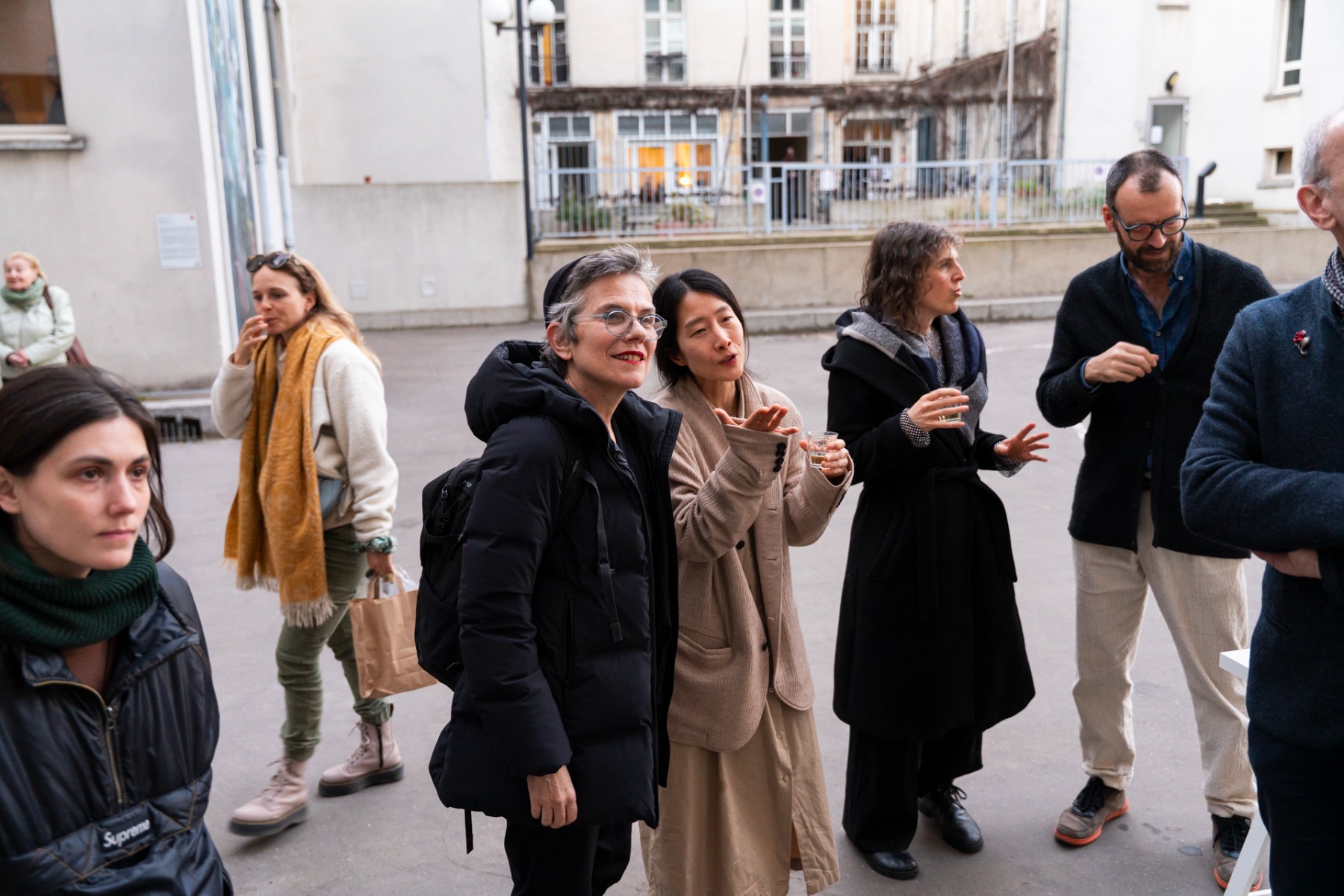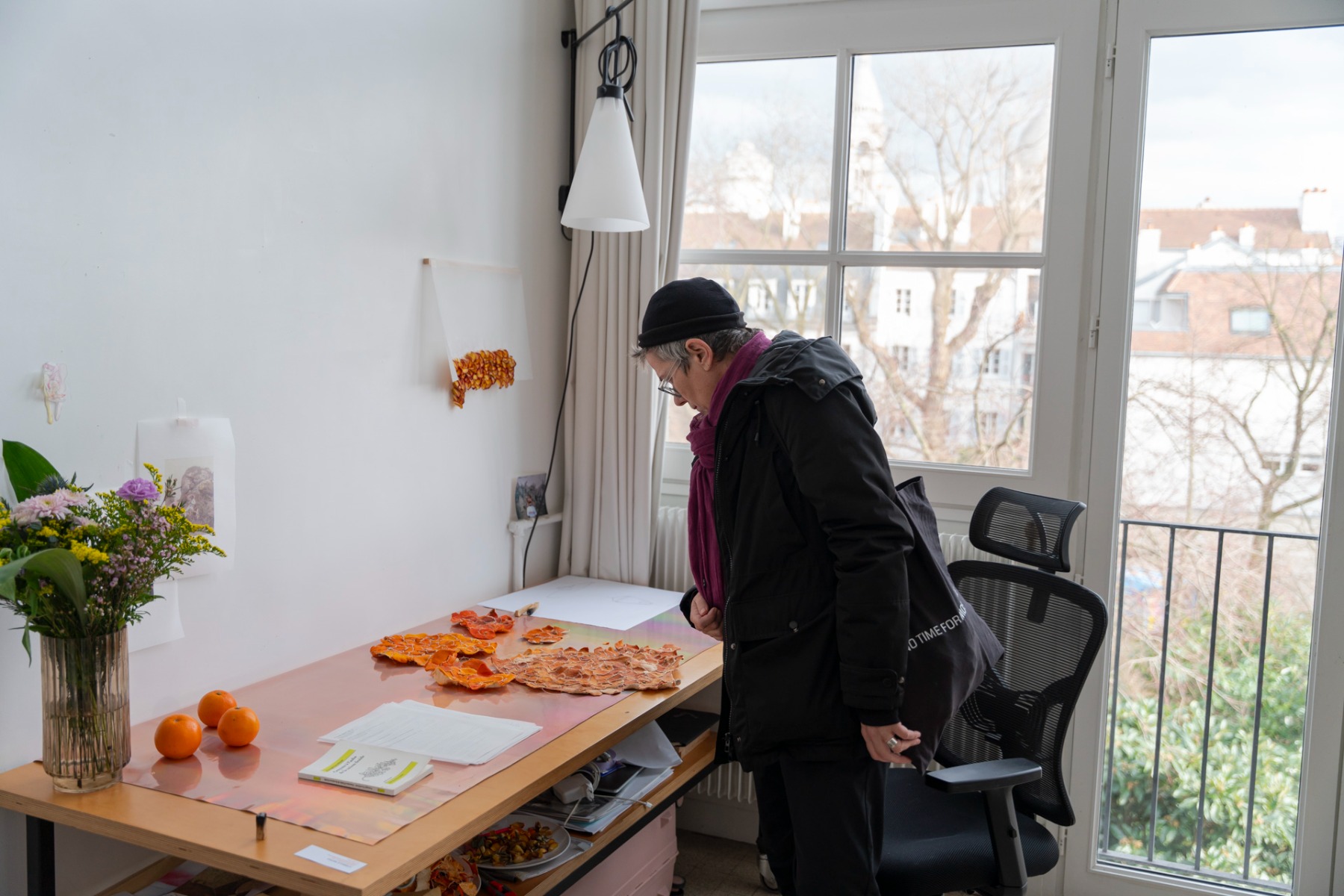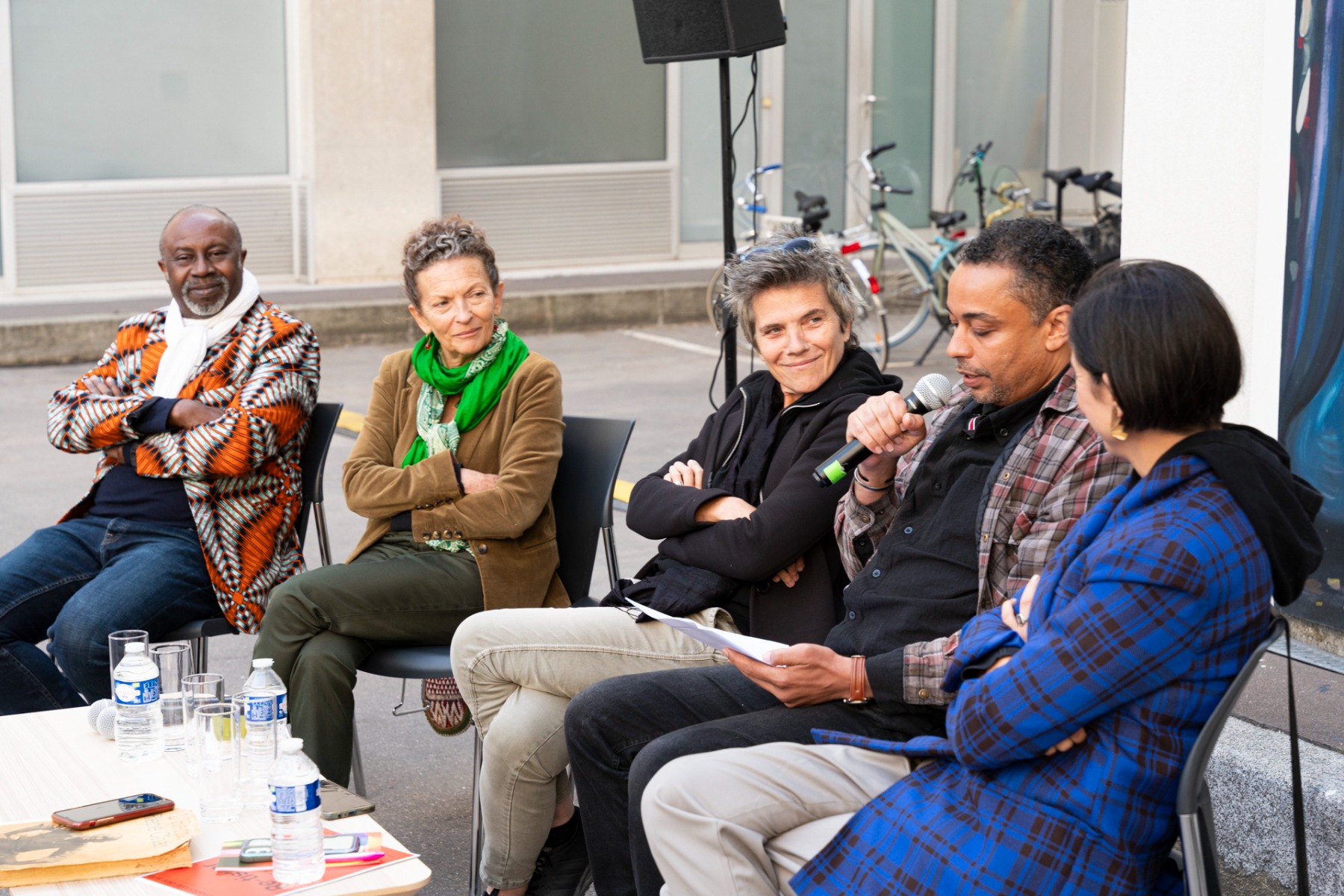
A space for human experience
Juste Kostikovaite*
An interview with Benedicte Alliot, the director of the Cité internationale des arts residency in Paris
When we speak in the heart of Paris a the Cité Des Arts in Paris it’s beginning of March 2025 and it’s the year when Cité internationale des arts is celebrating 60 years since it’s founding.
Benedicte Alliot, the director of this residency, is talking to me in her sunny office in Marais. A doctor in English studies and lecturer at the University of Paris – Diderot until 2002, Bénédicte Alliot was Director of the French Institute of South Africa in Johannesburg (2002– 2006), then Cultural Attaché at the French Embassy in New Delhi, India (2006– 2010). She then headed the Cultural Seasons unit at the Institut Français in Paris.
Since early 2016, Bénédicte Alliot has been heading the Cité internationale des arts, a residency centre in Paris Marais and Montmartre sites that welcomes the whopping 326 artists, writers, filmmakers, dancers, playwrights, etc. from more than 100 countries.
Opening night of the exhibition Trailblazers: feminisms, camera in hand and archive over the shoulder, October 2023 © Maurine Tric / Adagp, Paris, 2023
Such a beautiful sunny day. And a good sunny promise of celebrations of the 60 years of Cité. How has your role at the Cité evolved since you first started nine years ago? Also, how did your background helped you to get where you are now?
When I started nine years ago, I was very enthusiastic about the personal connections and understanding everyone’s experience. I remember that I had individual visits to the artists, but now I hardly have the time, except when the open studios take place on Wednesdays.
The correlation between my background and my current position is deeply tied to my academic career. I was in academia, focusing on African American and Caribbean literature, but I quit because I felt I was not in the right place. However, the research aspect stayed with me. That is why I feel at home with artists, curators, and writers who come with research – based projects. We should always make space for that – space for thinking processes, for thoughts.
The cultural diplomacy aspect of my work is completely in tune with who I am. I had the privilege of living abroad as a child thanks to my father’s job. It gave me a deep thirst for cultural affairs and for experiencing life in different countries. After leaving academia, I worked as a Cultural Attaché in South Africa and India. That experience taught me how to listen, how to observe, and how to make sense of what I hear and see – without imposing anything. That was a gift. And I think it’s something we should actively make space for at the Cité internationale des arts.
Bénédicte Alliot and Yena Young, Open Studios, Marais Site, March 2025 © Maurine Tric / Adagp, Paris, 2025
What does it mean to be an arts institution today – within France, Europe, and beyond?
There is an urgency to rethink what it means.
I am about to travel to the United States – Chicago, New York, Boston, and New Orleans – for, among other things, pursue conversations with the Joan Mitchell Foundation to explore the possibility of establishing a connection.
Why commemorate 60 years of a residency? What does it mean to historicize a space like this?
I arrived on February 29, 2016, and wrote an updated project for Cité, which is now being implemented. We are celebrating Cité as an art residency because we need to situate ourselves, improve hospitality, and renovate – not just the buildings, but the ways in which we support artists who come here. We also want to be more inclusive in many ways, making space for artistic scenes that are underrepresented. For example, we’ve developed collaborations with institutions in Chile and Portugal.
Bénédicte Alliot and Paula Valero Comín, Open Studios, Montmartre Site, June 2023 © Maurine Tric / Adagp, Paris, 2023
In a time when residencies are often linked to “soft power”, how does Cité navigate the politics of mobility? Is it even possible to be neutral?
We recently hosted artists from Cameroon and East Timor. The geopolitics of mobility are complex. In the case of Cameroon, we have a partnership there. With East Timor, we found the right partners at the right time, creating a reciprocal residency program. A Portuguese institution supports the project, as well as a French partner in Indonesia. It worked out beautifully.
I have an amazing team of 48 people making this residency happen – everyone from plumbers to electricians, technical staff to administrators. It requires real commitment.
You mentioned the word “neutrality”. We cannot represent every artistic scene in the world. We are already too big – 325 artists at the same time is crazy. But this is our legacy. The aim is not to represent everything. Sometimes we have to end partnerships. We are a nonprofit organization, not a public institution. The French state provides 2 % of our operational budget; 16 % comes from the City of Paris. Now we have developed programs with the State, bringing in around 700,000 EUR. It’s a proof of trust – supporting artists from Algeria, French – speaking artists from around the world. The program has been very successful. We work with around 200 partners who contribute financially to Cité.
Our overall budget is 6.5 million euros, which is very small for what we do. When I arrived, we started campaigning for some of our historical partners (you can see their names on the plaques by the doors) to renovate the studios. We’ve renovated 170 studios so far.
You can’t be more central in Paris (Cité in the Marais is next to the Seine river, and the site in Montmartre is very close to the Sacré Coeur).
Running an artist residency requires political engagement, but it must be rooted in human values. How do you activate a community of more than 300 artists? By facilitating meetings, creating opportunities. It’s a shared responsibility – between the partners, the artists, and the residency itself. How do you create the conditions for artists to work and get back to work? My strongest political stance is neutrality. We must be careful, we must listen. One should avoid propaganda at Cité.
I’ll give you an example – when Russia invaded Ukraine. I called the Ministry of Culture and said, as we did for Afghan artists when Kabul fell, “Something is going to happen in Ukraine. If you allow me, I will create a program to welcome Ukrainian and dissident Russian artists.” Then I secured the funding from a private donor. Russia invaded on February 24, 2022; eight days later, we welcomed the first Ukrainian artist. And I said to the Ministry: Wow, thank you for being so efficient.
Because we are a nonprofit organization, we are very reactive. Very dynamic. That’s crucial.
We accommodated Russian artists outside of Cité. Some artists started writing slogans on the windows. What we do is enable mobility. We don’t engage in cultural boycotts to demonstrate opposition to a regime. We do other things. If you visit our exhibitions, you understand where we stand. I think outright cultural boycotts are unfair and possibly unproductive.
Bénédicte Alliot in the Studio of Myriam Omar Awadi, Open Studios, Montmartre Site, February 2025 © Maurine Tric / Adagp, Paris, 2025
How do residencies shape the rhythm of artistic work? What does it mean to negotiate time and space?
It’s important to provide the time and space for focus. That’s what makes artist residencies so fascinating. They are about balancing daily life with research and creation.
It’s not just about what the city does to you – it’s also about what You, as a creator, do to the city. What do you leave behind? One has to admit that Paris is so much more cosmopolitan now. But the question is, what does it mean to be” “international” in Paris? I’m very interested in that question. The clichéd answer would be to say, “35,000 artists have passed through Cité, 16,000 of them women.” But it’s not just about the numbers. We have a huge responsibility towards these artists.
My idea was that Cité has never fully told its own story. That’s why we’re working on the Emersion: Living Archive (Archive Vivante) project, which will focus on the experiences of women and non– binary artists at Cité. We launched this project in 2022 with CIté and its European partners, as most of our residents come from Europe. Then we had an exhibition on Cité and the notion of hospitality. And we will continue telling our story, with a publication and programming, led by Nataša Petrešin - Bachelez, Head of Arts and Culture Programmes at Cité internationale des arts and the formidable team I have.
Bénédicte Alliot with Marianne Clevy, Hassane Kassi Kouyaté, Suhaib Gasmelbari et Julia Morandeira Arrizabalaga during the round table on the apprehension of language as a means of imagining new artistic and social existences, Re-Tisser, an event presented during the Festival Traversées du Marais, September 2024 © Maurine Tric / Adagp, Paris, 2024
What does it mean to decolonize the residency model? Can an institution truly decolonize itself?
I believe it is a continuous process and we are definitely a huge part of it. For example, we initiated a program for artists from French Polynesia. I wanted to involve French overseas territories. This is why our exhibitions tackle colonial legacies and historical atrocities. For example, “Le Mémoire des Hauts - Fonds” explored the artistic heritage of the overseas territories and the oceanic world.
Our exhibition “Ces Voix Qui M’assiègent” was also looking at these questions. From there, we continued with other exhibitions that addressed the real and symbolic violence, post-colonialism –because these are the conversations contemporary artists are having. Cité residency is a vessel for these discussions. We don’t dictate them; we make space for them. That is what makes us unique. We activate dialogue – through Open Studios, exhibitions, and artist meetings. The scale of Cité makes it unique in the world.
We also make space for disagreement. That’s crucial. Political arguments, debates, personal expression – this is what makes Cité possible.
I remember talking to a curator from Senegal who told me, “But you don’t have a film space, a theatre space.” And I said, “We are a space for human experience.” That experience is right in your face. Parisians might not always want to see it, but it’s there. It can be unsettling. But it is also deeply emotional – threads of thought and work coming to the surface. Yes, we’re humble, we do not have enough financial means, there’s a lot to renovate, but the sky is the limit!
Consensus is the worst thing that can happen nowadays, wherever. So – most importantly – we are the space for debates and talking and thinking.
*Curatorial residency of Justė Kostikovaitė at Cite des Arts International Paris was partly supported by the Lithuanian Culture Council.
Title image: Bénédicte Alliot, General Director, Cité internaitonale des arts © Maurine Tric / Adagp, Paris 2024